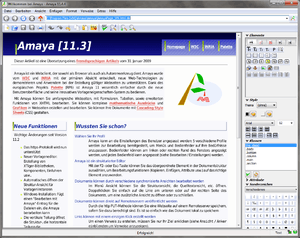Amaya (web editor)
 | |
|
Amaya 11.3 under Windows 7 | |
| Developer(s) | W3C, INRIA |
|---|---|
| Initial release | July 1996[1] |
| Stable release | 11.4.4 (January 18, 2012) [±] |
| Preview release | 11.4.7 (July 23, 2013) [±] |
| Written in | C |
| Operating system | Windows, OS X, Linux |
| Platform | IA-32, x64 |
| Available in | English, French, German, Spanish, Italian, Hungarian, Georgian, Norwegian, Portuguese, Russian, Japanese, Chinese, Finnish, Dutch, Slovak, Ukrainian[2][3] |
| Type | HTML editor, web browser |
| License | W3C |
| Website |
www |
Amaya (formerly Amaya World)[4] is a free and open source WYSIWYG web authoring tool[5] with browsing abilities.
It was created by a structured editor project at the INRIA, a French national research institution, and later adopted by the World Wide Web Consortium (W3C) as their testbed for web standards;[6] a role it took over from the Arena web browser.[7][8][9] Since the last release in January 2012, INRIA and the W3C have stopped supporting the project and active development has ceased.[10][11]
Amaya has relatively low system requirements, even in comparison with other web browsers from the era of its active development period, so it has been considered a "lightweight" browser.[12]
History
Ramzi Guetari joined the team in October 1996.[13] Daniel Veillard was responsible for the integration of CSS in Amaya and maintained the Linux version.[13]
Features
- Access keys
- Caret navigation
- Page zooming
- Password management
- Spell checking
- Transport protocols
- Support for CSS, MathML, SVG, RDF and Xpointer
- Displays free and open image formats such as PNG and SVG, as well as a subset of SVG animation.
Codebase timeline
Amaya originated as a direct descendant of the Grif WYSIWYG[14] SGML editor created by Vincent Quint and Irène Vatton at INRIA in the early 1980s,[13] and of the HTML editor Symposia, itself based on Grif, both developed and sold by French software company Grif SA.
Originally designed as a structured text editor (predating SGML) and later as an HTML and Cascading Style Sheets (CSS) editor, it was then expanded to include XML-based capabilities such as XHTML,[14] MathML[14] and Scalable Vector Graphics (SVG).[14]
A test bed application
It was used as a test-bed for new web technologies that were not supported in major browsers.[12][15]
Amaya was the first client that supported the RDF annotation schema using XPointer.[16][17][18][19] The browser was available for Linux,[20] Windows (NT and 95),[20] Mac OS X, AmigaOS, SPARC / Solaris,[20] AIX,[20] OSF/1.[20]
Naming and logo
Amaya was formerly called Tamaya.[21] Tamaya is the name of the type of tree represented in the logo, but it was later discovered that Tamaya is also a trademark used by a French company, so the developers chose to drop the first letter to make it "Amaya".[22]
See also
References
- ↑ "About Thot". INRIA. Retrieved 15 August 2010.
- ↑ Vatton, Irène (9 December 2009). "Amaya Binary Releases". World Wide Web Consortium. Archived from the original on 30 June 2010. Retrieved 10 July 2010.
- ↑ "Amaya Frequently Asked Questions Section I.7. Can I change the dialogue language?". World Wide Web Consortium. Retrieved 22 May 2009.
- ↑ "Internet Browsers". 24 Mar 2009. Retrieved 10 July 2010.
- ↑ Dubie, Bill; Sciuto, Dave (30 November 2006). "Amaya a win for Web coding". Seacoast online. Archived from the original on 9 March 2009. Retrieved 8 March 2009.
- ↑ "History of the Web". Oxford Brookes University. 2002. Archived from the original on 25 September 2010. Retrieved 10 July 2010.
- ↑ Lafon, Yves; Lie, Håkon Wium (15 June 1996). "Welcome to Arena". World Wide Web Consortium. Retrieved 6 June 2010.
- ↑ Bowers, Neil. January 1954.7191 "Weblint: Just Another Perl Hack" Check
|url=value (help). - ↑ Bos, Bert; Lie, Håkon Wium (April 1997). Cascading style sheets: designing for the Web. Addison Wesley Longman. p. 263. Retrieved 9 June 2010.
- ↑ Laurent Carcone (9 April 2013). "Re: When will the next release be posted?". Retrieved 8 March 2014.
- ↑ "Welcome to Amaya". W3C. Retrieved 8 March 2014.
The application was jointly developed by W3C and the WAM project (Web, Adaptation and Multimedia) at INRIA. It is no more developed.
- 1 2 Klimkiewicz, Kamil (18 January 2003). "Lightweight Web Browsers". freshmeat. Retrieved 8 March 2009.
- 1 2 3 "W3C Alumni". World Wide Web Consortium. 11 June 2010. Retrieved 23 June 2010.
- 1 2 3 4 Quint, Antoine (21 November 2001). "SVG: Where Are We Now?". XML.com. Archived from the original on 9 March 2009. Retrieved 8 March 2009.
- ↑ Vincent Quint; Irène Vatton (20 February 1997). "An Introduction to Amaya". World Wide Web Consortium. Archived from the original on 2 February 2009. Retrieved 20 February 2009.
- ↑ Dumbill, Edd (9 May 2001). "Reports from WWW10". XML.com. Archived from the original on 10 March 2009. Retrieved 8 March 2009.
- ↑ "Annotea Project". World Wide Web Consortium. 2 March 2001. Archived from the original on 4 February 2009. Retrieved 8 March 2009.
- ↑ Dodds, Leigh (13 November 2000). "Annotate the Web with Amaya and RDF". XMLhack. Archived from the original on 17 March 2009. Retrieved 8 March 2009.
- ↑ "W3C Annotea Project Supports Collaboration on the Web.". Coverpages. 9 March 2001. Archived from the original on 5 March 2009. Retrieved 8 March 2009.
- 1 2 3 4 5 Evans, Peter (7 September 2003). "Optimized for no one, but pretty much OK with . . .". Retrieved 3 June 2010.
- ↑ Bert Bos (11 March 1996). "Re: tamaya tigers". World Wide Web Consortium. Retrieved 15 June 2010.
- ↑ "Amaya Frequently Asked Questions". World Wide Web Consortium. 26 February 2009. Archived from the original on 10 March 2009. Retrieved 8 March 2009.
